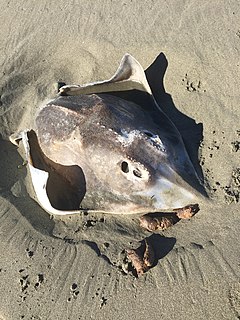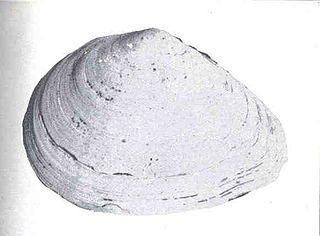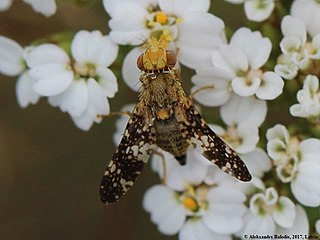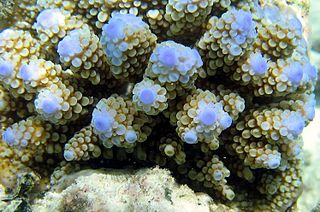
The New Zealand rough skate, Zearaja nasuta, is a skate of the genus Zearaja, found around New Zealand at depths between 10 and 1,500 m. Its length is up to 1 m. This species has been assessed by the IUCN as of Least Concern. In June 2018 the New Zealand Department of Conservation classified the New Zealand rough skate as "Not Threatened" with the qualifier "Conservation Dependant" under the New Zealand Threat Classification System.

The long-nosed bandicoot is a species of bandicoot found in eastern Australia, from north Queensland along the east coast to Victoria. Around 40 centimetres (16 in) long, it is sandy- or grey-brown with a long snouty nose. Omnivorous, it forages for invertebrates, fungi and plants at night.

The Encyclopedia of Life (EOL) is a free, online collaborative encyclopedia intended to document all of the 1.9 million living species known to science. It is compiled from existing databases and from contributions by experts and non-experts throughout the world. It aims to build one "infinitely expandable" page for each species, including video, sound, images, graphics, as well as text. In addition, the Encyclopedia incorporates content from the Biodiversity Heritage Library, which digitizes millions of pages of printed literature from the world's major natural history libraries. The project was initially backed by a US$50 million funding commitment, led by the MacArthur Foundation and the Sloan Foundation, who provided US$20 million and US$5 million, respectively. The additional US$25 million came from five cornerstone institutions—the Field Museum, Harvard University, the Marine Biological Laboratory, the Missouri Botanical Garden, and the Smithsonian Institution. The project was initially led by Jim Edwards and the development team by David Patterson. Today, participating institutions and individual donors continue to support EOL through financial contributions.
Edalorhina nasuta is a species of frog in the family Leptodactylidae. It is endemic to Peru. Its natural habitats are subtropical or tropical moist lowland forests and intermittent freshwater marshes. It is threatened by habitat loss.
Odorrana nasuta is a species of frogs in the family Ranidae that is endemic to Hainan, China. It occurs near streams in forested regions at elevations of 350–850 m (1,150–2,790 ft) asl. Breeding takes place in streams. It is threatened by habitat loss caused by smallholder farming activities and clear-cutting of forests.

The large-nosed wood turtle is one of nine species of turtle in the genus Rhinoclemmys of the family Geoemydidae. It is found in Colombia and Ecuador.

Ophthalmotilapia nasuta is a species of cichlid endemic to Lake Tanganyika. It can reach a length of 20 centimetres (7.9 in) TL. It can also be found in the aquarium trade.
The longnose darter is a species of fish in the Percidae family. It is endemic to the United States.

Macoma nasuta, commonly known as the bent-nosed clam, is a species of bivalve found along the Pacific Ocean coast of North America. It is about 6 cm (2.4 in) long. It is often found buried in sands of 10–20 cm (3.9–7.9 in) in depth. This rounded clam has no radial ribs. Archaeological data supports the use of this species by Native Americans such as the Chumash peoples of central California.
Pyrgomantis nasuta is a species of praying mantis found in Angola, Cape Province, Cameroon, Kenya, Natal, Namibia, Somalia, and Tanzania. It has previously been identified as Mantis nasuta and as Mantis capensis.
Rhynchobombyx is a monospecific moth genus in the family Lasiocampidae first described by Per Olof Christopher Aurivillius in 1908. It contains the single species Rhynchobombyx nasuta, described by the same author in the same year.

Oxyna is a genus of fruit flies in the family Tephritidae. There are at least 20 described species in Oxyna.

Cerylonidae are small to tiny, smooth, shiny, hairless beetles, only lightly punctured. There are about 450 species worldwide in 50 or so genera, mostly tropical and subtropical. They are most common under the bark of dead trees, but can also occur in compost and other decaying plant material. Little is known specifically about their biology but they are thought to be either predators that feed on other small animals or fungus eating.
Ethiopsella is a monotypic snout moth genus. Its only species, Ethiopsella nasuta, is found in Nigeria. Both the genus and species were described by George Hampson in 1930.
Mesoclemmys nasuta is a species of turtles that lives in Bolivia, Colombia, Peru, Brazil and the Guyanas.

iNaturalist is a citizen science project and online social network of naturalists, citizen scientists, and biologists built on the concept of mapping and sharing observations of biodiversity across the globe. iNaturalist may be accessed via its website or from its mobile applications. Observations recorded with iNaturalist provide valuable open data to scientific research projects, conservation agencies, other organizations, and the public. The project has been called "a standard-bearer for natural history mobile applications."

Acropora nasuta is a species of branching stony coral in the family Acroporidae. It is native to the western and central Indo-Pacific where it is found in shallow reef habitats. Like other corals of the genus Acropora, it is susceptible to coral bleaching and coral diseases and the IUCN has listed it as being "Near Threatened".
Bostaera is a genus of delphacid planthoppers in the family Delphacidae. There are about five described species in Bostaera.
Bostaera balli is a species of delphacid planthopper in the family Delphacidae. It is found in North America.

Lamarckiana is a genus of grasshoppers in the family Pamphagidae. There are about five described species in Lamarckiana, found in southern and eastern Africa.












